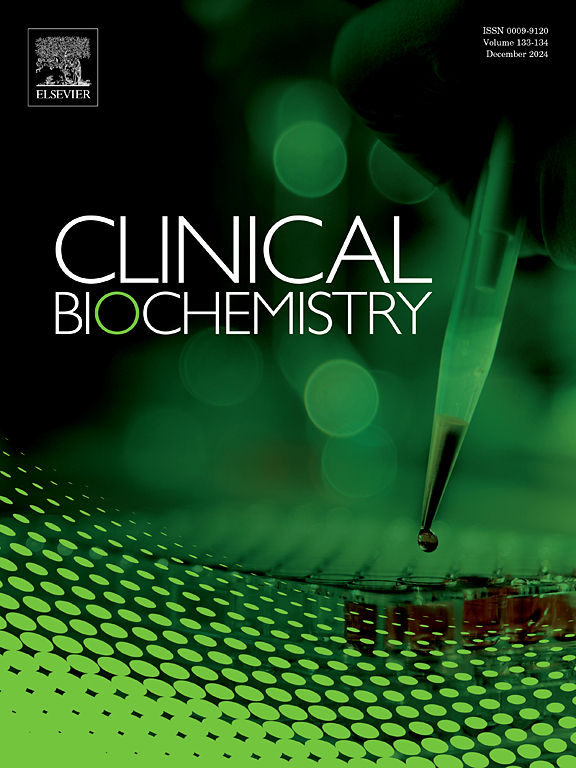CNPY2表达作为非小细胞肺癌的诊断和预后生物标志物
IF 2.5
3区 医学
Q2 MEDICAL LABORATORY TECHNOLOGY
引用次数: 0
摘要
背景:非小细胞肺癌(NSCLC)是最常见的肺癌类型。鉴定新的生物标志物对于提高早期发现和治疗效果至关重要。本研究探讨了冠层FGF信号调节因子2 (CNPY2)在非小细胞肺癌进展中的作用及其作为诊断和预后生物标志物的潜力。方法:采用定量RT-PCR和ELISA方法对228例NSCLC肿瘤及邻近正常组织中CNPY2的表达进行分析。160名健康对照者和非小细胞肺癌患者的血清CNPY2水平也被测量。评估CNPY2表达与临床病理特征(包括上皮-间质转化(EMT)标志物)之间的关系。采用接收算子曲线分析评价血清CNPY2的诊断潜力,Kaplan-Meier生存分析评价其预后意义。结果:与邻近正常组织相比,非小细胞肺癌组织中CNPY2水平显著升高。CNPY2的高表达与肿瘤大小、T分期和N分期相关。此外,CNPY2的表达与Vimentin和N-cadherin呈正相关,与E-cadherin负相关。NSCLC患者血清CNPY2水平升高显示出中等的诊断准确性,曲线下面积为0.78。高CNPY2表达也与总生存率降低有关(p = 0.001)。结论:CNPY2在NSCLC中明显过表达,并与肿瘤侵袭性和EMT增加相关。血清CNPY2有望作为非侵入性非小细胞肺癌诊断的生物标志物,其表达升高与预后较差相关。因此,CNPY2可能既是一种有价值的生物标志物,也是非小细胞肺癌的潜在治疗靶点。本文章由计算机程序翻译,如有差异,请以英文原文为准。
The expression of canopy FGF signaling regulator 2 serves as a diagnostic and prognostic indicator for NSCLC
Background
Non-small cell lung cancer (NSCLC) is the most common type of lung cancer. The identification of new biomarkers is crucial for enhancing early detection and treatment outcomes. This study explores the role of Canopy FGF Signaling Regulator 2 (CNPY2) in NSCLC progression and its potential as a diagnostic and prognostic biomarker.
Methods
CNPY2 expression was analyzed in 228 NSCLC tumor samples and adjacent normal tissues using quantitative RT-PCR and ELISA. Serum CNPY2 levels were also measured in 160 healthy controls and NSCLC patients. The relationship between CNPY2 expression and clinicopathological features, including epithelial-mesenchymal transition (EMT) markers, was assessed. Receiver operator curve analysis was used to evaluate the diagnostic potential of serum CNPY2, while Kaplan-Meier survival analysis assessed its prognostic significance.
Results
CNPY2 levels were significantly elevated in NSCLC tissues compared to adjacent normal tissues. Higher CNPY2 expression was associated with larger tumor size, advanced T stage, and higher N stage. Furthermore, CNPY2 expression was positively correlated with Vimentin and N-cadherin, and negatively correlated with E-cadherin. Elevated serum CNPY2 levels in NSCLC patients demonstrated moderate diagnostic accuracy, with an area under the curve of 0.78. High CNPY2 expression was also linked to reduced overall survival (p = 0.001).
Conclusions
CNPY2 is markedly overexpressed in NSCLC and is associated with increased tumor aggressiveness and EMT. Serum CNPY2 shows promise as a non-invasive biomarker for NSCLC diagnosis, and elevated expression is correlated with a poorer prognosis. Thus, CNPY2 may serve as both a valuable biomarker and a potential therapeutic target in NSCLC.
求助全文
通过发布文献求助,成功后即可免费获取论文全文。
去求助
来源期刊

Clinical biochemistry
医学-医学实验技术
CiteScore
5.10
自引率
0.00%
发文量
151
审稿时长
25 days
期刊介绍:
Clinical Biochemistry publishes articles relating to clinical chemistry, molecular biology and genetics, therapeutic drug monitoring and toxicology, laboratory immunology and laboratory medicine in general, with the focus on analytical and clinical investigation of laboratory tests in humans used for diagnosis, prognosis, treatment and therapy, and monitoring of disease.
 求助内容:
求助内容: 应助结果提醒方式:
应助结果提醒方式:


